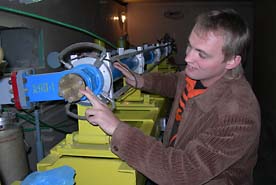X-Ray generator project builds capacity among young nuclear scientists in Ukraine
The NESTOR project, which is developing a revolutionary X-ray generator, has engaged a new generation of nuclear scientists in Ukraine. Launched in January 2003 and nearing completion, this is one of the longest-running projects under the NATO Science for Peace and Security (SPS) Programme.

Producing high resolution X-rays at a fraction of the cost

The purpose of the NESTOR project, short for New Electron Storage Ring, is to build an X-ray generator. The machine consists of two parts. The first part accelerates electrons to a very high speed. In the second part, a laser beam interacts with the accelerated electrons to produce high-energy X-rays. These X-rays are necessary for creating the high-resolution images required in medicine, forensics and environmental security, as well as in detecting illicit trafficking and explosives.
Building high-energy X-ray generators can be very expensive. Normally they cost anywhere from 200 million to 1 billion Euros. Measuring between 700 to 1,500 metres in circumference, space can also be an issue. But the X-ray generator built as part of the SPS project takes up significantly less space and can be produced at a fraction of the cost without compromising range or energy level.
Utilising advanced laser and storage ring technologies, “it creates the energy needed in a small amount of space,” explains Dr Philippe Fougerolle, SPS Associate Programme Director. The machine is only around 15 metres in circumference and costs less than 2 million Euros. Located at the National Science Centre’s Kharkiv Institute of Physics and Technology (NSC KIPT) in Ukraine, the size of the device allows it to be placed in the basement of smaller buildings.
Building scientific capacity in Ukraine
The project has an additional benefit as well: engaging nuclear scientists, while promoting investment in scientific research and development in the Ukraine following the collapse of the former Soviet Union. One of the purposes of the project is “to maintain the nuclear scientists, to give them the tools to keep them working and to attract young scientists,” says Dr Fougerolle.
An important priority was to address the problem of an aging scientist population and to build capacity among a new generation of scientists, while helping to ensure that Ukraine would be able to retain them. “Many scientists and other staff are at the age where we in Western Europe would have been retired for years,” points out Jan Botman, NATO Project Director. “It seems that at NSC KIPT it is mainly the NESTOR projects on which younger scientists, technicians and students are involved.” Of the team of 42 working on the project, 18 are young scientists.
A centre of modern technological development in Kharkiv
The NESTOR facility itself serves as a showcase of modern technological development, providing equipment and training for the National Science Centre. Over the course of the project, Kharkiv has become a scientific nucleus in Ukraine, setting an example for other universities and scientific institutes.
“Because of the modern equipment being applied, largely from NATO support, the modern design and the sophisticated technology, the NESTOR project is one of the most important projects of the institute,” highlights Mr Botman.
Supported by Ukraine, Germany, Russia and the Netherlands, the project was carried out by the NSC KIPT with support from Eindhoven University of Technology.
